How Much Money Does The Average Movie Gross In Sales
 This is an article I have wanted to enquiry and write for a long, long time. I finally had a moment to sit and crunch the numbers – I promise it helps in the understanding of Hollywood economics. It'southward a lengthy i, then grab a cup of tea.
This is an article I have wanted to enquiry and write for a long, long time. I finally had a moment to sit and crunch the numbers – I promise it helps in the understanding of Hollywood economics. It'southward a lengthy i, then grab a cup of tea.
Every six months or so, someone on my Facebook feed will share a list of "The Most Profitable Movies of All Time". These lists normally use the budget of the picture and the amount of money it collected in cinemas worldwide to conclude how much "turn a profit" the movies made. For instance, "Paranormal Action price $15,000, grossed $193 million and and so fabricated a turn a profit 1,286,566%". Another popular fallacy is that when a motion-picture show with a $100 million budget crosses $100 million at the box function it is considered to take "recouped".
While I understand why people autumn for such over-simplifications, they accept no real connexion with how movies actually make money. Therefore, in an endeavor to demystify the flick recoupment procedure I'chiliad going to write a few articles looking at how movies make a profit. In the coming weeks, I'll look at movies with smaller budgets but let's start with the big ones – Hollywood blockbusters.
"We're going to demand a bigger gunkhole"
 Virtually as long as there accept been movies, Hollywood has relied on huge-scale productions to bring in the big bucks. Movies similar Gone With The Air current, Ben-Hur and Cleopatra attracted big movie theatre audiences with a promise of cinematic spectacle. However, the showtime 'blockbuster' in the modern sense was Jaws (1975). The moving picture bankrupt box office records and created the mod summertime blockbuster as we know it today. Its broad national release supported by blitz advertising created the first 'event movie' and became the template for later blockbusters including Star Wars (1977), Raiders of the Lost Ark (1981) and East.T. The Extra-Terrestrial (1982).
Virtually as long as there accept been movies, Hollywood has relied on huge-scale productions to bring in the big bucks. Movies similar Gone With The Air current, Ben-Hur and Cleopatra attracted big movie theatre audiences with a promise of cinematic spectacle. However, the showtime 'blockbuster' in the modern sense was Jaws (1975). The moving picture bankrupt box office records and created the mod summertime blockbuster as we know it today. Its broad national release supported by blitz advertising created the first 'event movie' and became the template for later blockbusters including Star Wars (1977), Raiders of the Lost Ark (1981) and East.T. The Extra-Terrestrial (1982).
In the past few decades, Hollywood studios have sought to perfect the model, and in so doing have massively increased the cost of making and promoting such movies. Modern blockbusters are oftentimes referred to as 'tentpole movies' every bit they correspond the most important products in a studio'south release calendar. As the films have grown, so too accept the spoils on offer. Last year, Jurassic World earned a whopping $1.67 billion in cinemas worldwide; quite a haul for a movie which toll $150 million to make. But later they recouped the original budget, how much of the remaining $i.52 billion turns into turn a profit?
For today's data, I am using a dataset of 29 Hollywood blockbusters, all of which price over $100 million to make. The financial figures come from a few dissimilar sources within Hollywood studios, which I discuss in the Epilogue section at the end of this article. For now, just know that these figures are real-earth, correct and relate to Hollywood movies released in the past ten years which toll over $100 million to make. (Note: The images and posters used in this commodity do not relate to the movies in my dataset – I've picked them considering they're overnice images which seem to fit in well with the text).
What's the average cost of making and selling a Hollywood blockbuster?
 Before we tin go to the numbers, here are some key phrases y'all'll need to know to empathize Hollywood economics…
Before we tin go to the numbers, here are some key phrases y'all'll need to know to empathize Hollywood economics…
- Domestic – The release of the film in America and Canada, too known as "Due north America".
- International – The release of the film in the remainder of the world combined. In some cases, studios will only have the rights to release a movie domestically, with another visitor picking upward the international rights (or vice versa). For example, Paramount have the rights to distribute The Adventures of Tintin domestically while Sony controls the international rights.
- Theatrical – Relating to the cinema release (i.e. in movie theatres).
- Domicile Entertainment (or "Home Video" or "Home Ent") – The release of the film on DVD, Blu-Ray, previously VHS and online streaming services.
- Pay TV – Subscription television channels. In the UK this includes Sky Cinema and in the U.s.a. cablevision networks such as HBO.
- Free Telly – Gratuitous to air television, typically either public service broadcasting or ad supported. In the UK this includes the BBC and in the US ABC.
- Video on Demand (VOD) – Online streaming services (such as iTunes, Netflix and Amazon Prime).
- Pay Per View (PPV) – An erstwhile form of VOD which is still active in some places involving the viewer paying to sentry an encrypted, scheduled transmission of the movie.
Ok, enough terminology – let's start our journeying into what Hollywood blockbusters cost and what they make dorsum.
The outset huge cost – The upkeep
 The starting betoken for working out the terminal costs of releasing a pic is to expect at how much it toll the studio to shoot the moving picture (i.eastward. the moving picture'southward upkeep). In the industry, this is ofttimes called the 'Negative Cost' every bit it's the cost of producing the very first version of the moving-picture show (which used to exist a motion-picture show negative). This includes…
The starting betoken for working out the terminal costs of releasing a pic is to expect at how much it toll the studio to shoot the moving picture (i.eastward. the moving picture'southward upkeep). In the industry, this is ofttimes called the 'Negative Cost' every bit it's the cost of producing the very first version of the moving-picture show (which used to exist a motion-picture show negative). This includes…
- Development – Getting to a concluding script
- Pre-product – Edifice a squad and planning the shoot
- Production – Shooting the movie
- Post-production – Editing, visual effects, sound blueprint and music.
It volition include most of the cast and crew's wages merely probably not the total amount paid to key personnel, such as the director or pb actors. These people may go additional money based on how well the picture show performs (known as "Contingent Compensation") or a share of the coin leftover once all the bills are paid (known as "Turn a profit Participation").
Budgets take been ascension in recent decades, well above inflation. In the 10 years between 1995 and 2004, there were 60 Hollywood movies released which toll over $100 million. In the following ten years (2005-14) this rose to 197.
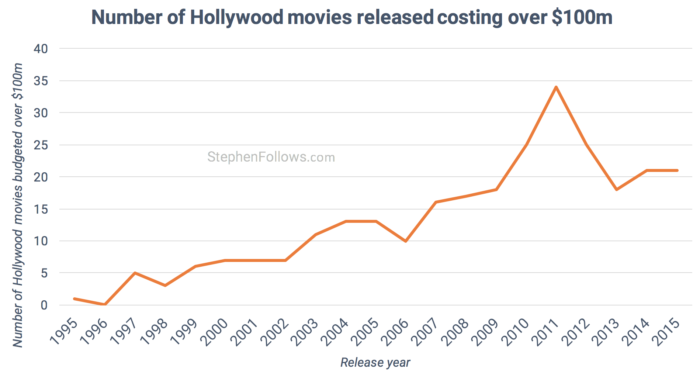
The studios found themselves in an ever-increasing screw whereby blockbusters were getting more than expensive to brand, pregnant that they needed to spend more on marketing to offset the risk, which meant they needed to ensure their films are the biggest of the season, which inflated the budgets and the circle continues to turn.
Many feel that this bike is not sustainable and a few years ago some industry watchers felt that a huge crash was imminent (Steven Spielberg and George Lucas both predicted an industry 'implosion'). In the end, it seems that Hollywood has just reigned in spending with 2014 and 2015 having only 21 movies apiece, far below 2011's high of 34.
Discovering the size of a moving picture's budget
 Although technically a hole-and-corner, a film's total budget oftentimes leaks out and they are easy to notice online (for example, Googling the phrase "Jurassic World budget" reveals that it reportedly cost $150 million to make). The information available online is normally a mix of truthful figures which have leaked and educated guesses by manufacture experts.
Although technically a hole-and-corner, a film's total budget oftentimes leaks out and they are easy to notice online (for example, Googling the phrase "Jurassic World budget" reveals that it reportedly cost $150 million to make). The information available online is normally a mix of truthful figures which have leaked and educated guesses by manufacture experts.
The studios oft attempt to hibernate the true price of a movie, in social club to brand themselves seem thriftier, smarter or more in control than they actually are. I performed a quick cheque for the 29 blockbusters I have inside information on compared with their budgets listed on Wikipedia. 90% of the films price more than their Wikipedia upkeep with but three costing less than is declared on Wikipedia.
And then the boilerplate $100m+ Hollywood blockbuster actually cost $19 one thousand thousand more than is stated on Wikipedia (i.e. 12.5% more).
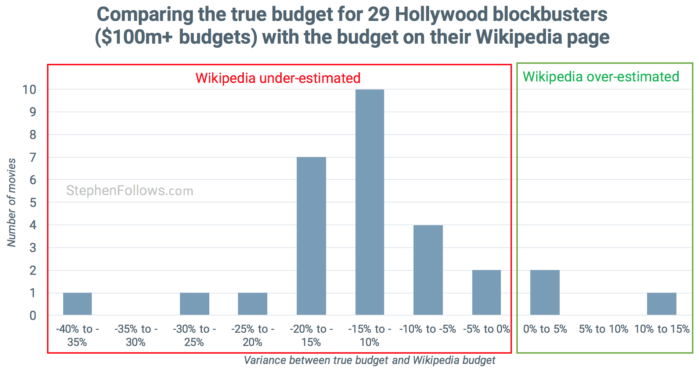
For reference, the average budget for the blockbusters in my dataset was $150,567,000.
Other costs of making a motion picture
 Releasing a Hollywood blockbuster involves far more than only creating 90 to 120 minutes of footage. Some of the other costs involved in making and releasing a flick include…
Releasing a Hollywood blockbuster involves far more than only creating 90 to 120 minutes of footage. Some of the other costs involved in making and releasing a flick include…
- Marketing – It could be argued that success in the concern of Hollywood blockbusters is more than dependent on the art of marketing than the art of filmmaking. This is the biggest category of costs for a flick, outside of the budget. Nigh Hollywood blockbusters only accept 1 or two weeks when they are 'The Big Movie' in cinemas, so studios need to build and aqueduct the sensation / excitement for a picture show to ensure that everyone goes to run into it during this period.
- Prints – The concrete copies of the films which are given to cinemas. Historically, they were on 35mm celluloid flick but today most countries use a difficult drive with a specially encoded digital video file called a Digital Cinema Impress (DCP). This difficult drive has a huge copy of the picture (10s or 100s of Gigabytes) and a tiny file which controls the permissions to the big video file. This means that hard drives can be shipped to cinemas in advance, without worry that the pic will exist viewed ahead of its official release. Complex permissions can be set, permitting screenings only at certain times or on certain digital projectors. Likewise, copies of the film in other formats will demand to be created to give to third parties distributors and exhibitors, such as TV stations who broadcast the film.
- Residuals – Unions for the cast and crew accept agreed deals with Hollywood studios which ensure that their members receive additional payments from the income the motion picture generates.
- Financing costs – These can include costs involved with borrowing money to make the film (interests and brokerage fees) and currency conversions (for overseas shoots).
- Overhead – Studios charge their own productions an overhead fee which covers the fourth dimension studio staff spend on the project, the costs of deals which apply to all films the studios make and the benefit a production is regarded as receiving from operating under the studio brand. It may seem foreign to charge oneself money simply these costs come off earlier "profit" is calculated, meaning that productions which pay an overhead have smaller official profits, significant that the studio has smaller cheques to cut to people with profit participation deals. The old joke in Hollywood is that the studios charge overhead on interest and involvement on overhead (and if y'all find that funny y'all really are down the rabbit hole of Hollywood economics!)
Looking at my dataset we can run into the average costs breakdown below…
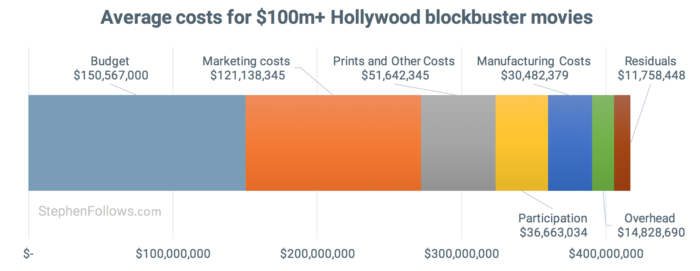
To requite you a little more detail and context, beneath are some notes on each of the main cost areas…
Marketing costs
 Is it oft claimed that marketing a Hollywood movie can cost up to twice of the price of the film'southward budget, however from the numbers above we can see that this is untrue. Across my dataset of $100m+ movies, the average budget was $150.6 million and the boilerplate combined marketing spend was $121.1 one thousand thousand (i.e. 81% of the budget).
Is it oft claimed that marketing a Hollywood movie can cost up to twice of the price of the film'southward budget, however from the numbers above we can see that this is untrue. Across my dataset of $100m+ movies, the average budget was $150.6 million and the boilerplate combined marketing spend was $121.1 one thousand thousand (i.e. 81% of the budget).
When expressed every bit a percentage of the total costs involved with making and selling a movie, marketing accounts for an average of 29% of costs. Across my dataset, the largest proportion of total costs going towards marketing was 40% and the lowest was 24%. It seems that the larger a movie's upkeep, the smaller a percentage marketing makes of the full cost. While this may at first seem strange (we normally acquaintance bigger movies with having bigger marketing budgets), consider that even films on the lower end of my dataset have budgets over $100 million and so their marketing efforts will exist pulling no punches. In short, once you make a movie over $100 million you lot're already using saturation marketing tactics then if you double a movie's budget you can't really double the marketing spend.
Physical delivery costs
 The physical costs of creating and shipping prints to cinemas and of creating and aircraft physical media to stores business relationship for an boilerplate of $67.8 million. Judging the correct number of prints and units to manufacture is a key part of the planning washed by the studios. If they order too few then cinemas and stores will have to plow away customers in the all-important first few weeks of release. If they over-order and then their costs increase and they are left with annoyed movie theater owners and large quantities of unsold units. Most units are sold on a 'Sale or Return' basis significant that if studios over order then it's their problem, not the stores.
The physical costs of creating and shipping prints to cinemas and of creating and aircraft physical media to stores business relationship for an boilerplate of $67.8 million. Judging the correct number of prints and units to manufacture is a key part of the planning washed by the studios. If they order too few then cinemas and stores will have to plow away customers in the all-important first few weeks of release. If they over-order and then their costs increase and they are left with annoyed movie theater owners and large quantities of unsold units. Most units are sold on a 'Sale or Return' basis significant that if studios over order then it's their problem, not the stores.
In 2005, Dreamworks overestimated the number of Shrek 2 DVDs they would sell in the US past 5 1000000 units. This caused the studio to missing their quarterly earnings target by 25% and their shares fell as a result.
Profit participation
 The average $100m+ Hollywood blockbuster will spend $36.6 million on contingent compensation and profit participation. This typically goes to the key 'creatives' involved in making the film – namely the managing director, producer(s), writer(s) and primal cast.
The average $100m+ Hollywood blockbuster will spend $36.6 million on contingent compensation and profit participation. This typically goes to the key 'creatives' involved in making the film – namely the managing director, producer(s), writer(s) and primal cast.
Giving these people a share of the income is a good way for the studio to hedge confronting poor box office operation and it too defers the moment they have to pay up. Key talent often seek 'participation points' as a way of increasing their income and to share the spoils if a film performs much ameliorate than expected.
On the flipside, studios take got rather proficient at using creative bookkeeping techniques to show that they made a loss on newspaper in order to go out of paying such fees. In 2010, a leaked profit participation report from the 5th Harry Potter motion picture showed that two years after the moving picture'southward release, Warner Brothers was challenge that the moving-picture show had lost $167 one thousand thousand. Other movies hit with such claims are the three Lord of the Rings films (which combined grossed almost $3 billion in cinemas worldwide), My Big Fat Greek Wedding, Spider-Homo, Return of the Jedi, Coming To America, JFK, Fahrenheit 9/eleven and Wood Gump, to name just a few.
The movie in my dataset which gave the largest share of income to participants gave 18%. It'south worth noting that participation isn't ever dependent on there beingness profits. As people become wise to the studios' game of artistic accounting they are asking for more than than just "a share of the profits". The biggest names volition demand 'Commencement Dollar Gross' deals, which give them a share of every dollar earned, calculated before costs are taken off. On average, the films which lost money in my dataset still paid out 5% of their income to participants (assisting films spent an boilerplate of 9% of their income on participants).
How practice Hollywood blockbusters earn money?
With each "$100m+" Hollywood blockbuster costing an boilerplate of $417 meg to make, in that location had improve exist some serious income to reach profitability. Fortunately, Hollywood is rather skillful at squeezing every penny out of a movie, ensuring that the target customer is given many chances to pay to see it. Before we expect at the financial figures, permit'due south talk briefly nearly the journey a movie goes on to earn its money.
Movies may get-go in cinemas only they are far from the only place they earn money. Each stage at which a picture show reaches a new type of platform (i.e. DVD, Television, etc) is called a "Release Window". In recent years release windows take shifted around (including the emptying of a previously-profitable exclusive window called "Video Rental" – remember renting a VHS at Blockbusters, anyone?) merely most Hollywood movies follow the same path.
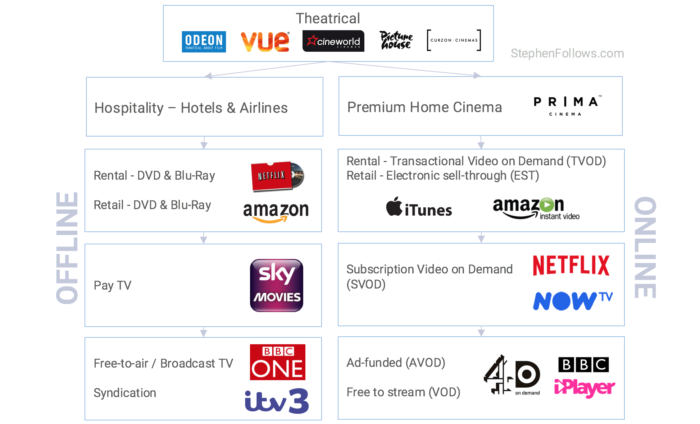
-
 Theatrical – Once yous've gone to the time and expense of creating a blockbuster you'll desire to ensure you pick a release timetable which maximises possible returns then studios advisedly plan each motion picture'south release strategy. Studios announce their cinema release dates manner in advance in order to merits coveted release spots, such as Warner Brothers who appear a release date for their superhero movie 'Cyborg' i,411 days ahead of time (information technology's out in America on 3rd April 2020). I don't have time to go into the movie house scheduling patterns of blockbusters here simply I have written most release calendars in the past stephenfollows.com/hollywood-film-release-pattern.
Theatrical – Once yous've gone to the time and expense of creating a blockbuster you'll desire to ensure you pick a release timetable which maximises possible returns then studios advisedly plan each motion picture'south release strategy. Studios announce their cinema release dates manner in advance in order to merits coveted release spots, such as Warner Brothers who appear a release date for their superhero movie 'Cyborg' i,411 days ahead of time (information technology's out in America on 3rd April 2020). I don't have time to go into the movie house scheduling patterns of blockbusters here simply I have written most release calendars in the past stephenfollows.com/hollywood-film-release-pattern. - Airlines and Hospitality – After the theatrical window, the film will appear on airlines and premium Pay Per View (PPV) services such as in hotels. If you're rather well-off then yous can go admission to this release window by forking out $35,000 for a Prima box and $500 per 24-hr movie rental. However, most of usa mere mortals need to expect for the all-important third window – Dwelling Entertainment.
- 'Dwelling house Entertainment' used to be divide into a rental window and then a retail window, even so currently they tend to appear on shelves at the same time. The length of time between the Theatrical and Habitation Entertainment windows is a hot topic in the industry. Studios want to reduce the time information technology takes for movies to move from cinemas to stores in lodge to capitalise on marketing efforts and to make sure the DVD is on sale when the film is still fresh in the minds of consumers. However, cinemas saw what happened to the rental window (which was chipped away to nothing, leading to the destruction of the video rental store industry) then they baby-sit their exclusive menses viciously. In 2015, the average release window between theatrical and Dwelling Entertainment was iii months and 23 days.
-
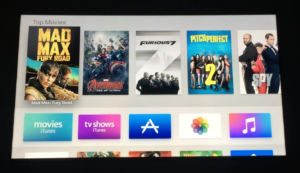 Video on Demand is the new hope which the industry is counting on to replace falling DVD income. Enquiry I conducted last year, showed that the amount of fourth dimension between the DVD and VOD release of the top 100 grossing movies has fallen considerably in recent years. In 2009, VOD consumers had to wait an average of 74 days after the DVD release just by 2014 this had fallen to just 14 days.
Video on Demand is the new hope which the industry is counting on to replace falling DVD income. Enquiry I conducted last year, showed that the amount of fourth dimension between the DVD and VOD release of the top 100 grossing movies has fallen considerably in recent years. In 2009, VOD consumers had to wait an average of 74 days after the DVD release just by 2014 this had fallen to just 14 days. - Tv is the largest single source of income for British films, mostly thanks to the collapse of the DVD market in recent years (see more than on this in my article from Jan this year stephenfollows.com/television set-income-for-films). Hollywood studios agree details with broadcasters called 'Overall Deals' (also chosen 'Output deals') which cover all of their movies over a certain catamenia for a stock-still, pre-agreed fee. This gives the studios a reliable income and gives the broadcasters a steady supply of hot new content which their rivals can't screen. At first, movies appear on premium channels (known every bit 'Pay TV'), and so they move their mode to free-to-air channels and finally end upward in Syndication on minor digital channels. Some premium Pay TV channels pay extra for the rights to screen a picture earlier information technology's available on DVD or VOD then the studios will exist careful to craft a release pattern which maximises income.
- Merchandising – A last major source of income for Hollywood Blockbusters is 'Consumer Products' (or merchandising). This involves the studios licencing the rights to use aspects of the movie's world (such as characters, items and places). An offshoot of this is Production Placement where the studios charge brands to feature their products in the film. Sometimes this volition appear as cash in the income of a movie but more often it'due south a way of saving money inside the motion-picture show'due south budget or getting access to requirement elements for costless (such equally Michael Bay's deal with Ford who supply 100s of cars to destroy for each of his exposition-heavy crash-fests).
How much money do Hollywood blockbusters make?
Using my dataset of $100 meg+ movies, I can share how much each of the sources of income contribute towards the bottom line.
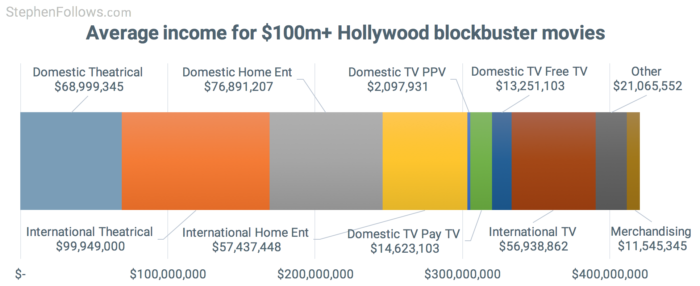
-
 Theatrical is the largest income commuter for films, although not the virtually assisting. The average picture in my dataset grossed $129.9 one thousand thousand domestically (i.due east. the Us and Canada) and $243.3 million internationally (i.east./ everywhere else), leading to a total box office gross of $373.2 meg. This is the figure you will hear reported on the news (i.e. "$100 million movie grosses $373 1000000 – what a success !"). Even so, before the studios can meet any of that money, two big costs needs to be deducted – sales taxes and the cinema's share. Studios received an average of 53% of the box office gross domestically and 41% of the international gross. So that $373 meg gross has already shrunk downwardly to $169 1000000. When we remove the average theatrical marketing costs of $98 1000000 we're left with a margin of $lxx million (i.e. 42% of the income). Other costs apply (see higher up) but already we can see how a $373 one thousand thousand gross tin can dwindle abroad fast.
Theatrical is the largest income commuter for films, although not the virtually assisting. The average picture in my dataset grossed $129.9 one thousand thousand domestically (i.due east. the Us and Canada) and $243.3 million internationally (i.east./ everywhere else), leading to a total box office gross of $373.2 meg. This is the figure you will hear reported on the news (i.e. "$100 million movie grosses $373 1000000 – what a success !"). Even so, before the studios can meet any of that money, two big costs needs to be deducted – sales taxes and the cinema's share. Studios received an average of 53% of the box office gross domestically and 41% of the international gross. So that $373 meg gross has already shrunk downwardly to $169 1000000. When we remove the average theatrical marketing costs of $98 1000000 we're left with a margin of $lxx million (i.e. 42% of the income). Other costs apply (see higher up) but already we can see how a $373 one thousand thousand gross tin can dwindle abroad fast. - Habitation Entertainment earns $100m+ Hollywood blockbusters an average of $134.three million per moving-picture show. The margin is higher that the theatrical window, with an average Abode Ent marketing spend of $21.nine million, leaving an 84% margin afterwards marketing. Patently, Dwelling house Ent has college manufacturing costs, but these are an average of $30.5 1000000, making Dwelling house Ent a richer vein than theatrical. Now yous tin can see why the studios are so worried by the fall in DVD sales!
- Television generates an average income of $86.9 million for $100 one thousand thousand+ movies and does so with little to no direct costs. Studios typically nonetheless charge a distribution fee to cover their time and lawyers merely this is minute in comparison with the marketing and manufacturing costs of Theatrical and Home Ent. Within North America, the Pay Boob tube window generates a slightly higher income than Free Goggle box (average of $14.6m versus $13.3 one thousand thousand, respectively).
- Video on Demand performed very poorly for these blockbusters, with most half of the films earning under 1% of their total income from VOD. That said, my dataset spans ten years and the studios were slow to build serious VOD operations. Looking just at the films released since 2011 reveals that 4.1% of their income came from VOD.
-
 Merchandising generated an average of $11.5 one thousand thousand per motion picture in my dataset simply this hides some large variations betwixt titles. Only a third of movies earned over $1 million and almost 2-thirds of the merchandising money generated from all 29 movies combined came from simply 2 movies. It seems that the biggest Hollywood blockbusters can get upwards to half of their budget back in merchandising lonely.
Merchandising generated an average of $11.5 one thousand thousand per motion picture in my dataset simply this hides some large variations betwixt titles. Only a third of movies earned over $1 million and almost 2-thirds of the merchandising money generated from all 29 movies combined came from simply 2 movies. It seems that the biggest Hollywood blockbusters can get upwards to half of their budget back in merchandising lonely. - Airline and Music income can exist viewed in ane of two ways. Information technology could be regarded as pretty inconsequential (totalling equally it does simply $2.seven million per movie) or information technology could exist viewed as among the easiest deals with footling to no costs associated.
Practice Hollywood movies make money?
Of the 29 Hollywood blockbuster movies I studied, 14 generated a profit and fifteen lost money. It'southward incommunicable to know if these stats hold true for mega-movies in all of Hollywood simply I doubtable they do, due to the way my dataset was created (see Epilogue).
Annotation: The following discussion of profit uses this formula: all acquirement received by the studios from a particular movie minus all costs they internally attribute to that production. This is an of import distinction as a movie which has only officially cleaved even could notwithstanding have provided a large amount of income for the studio via the charging of distribution fees, overhead and financing costs (come across higher up for the section on Hollywood's creative accounting).
The smallest movies within my dataset (i.e. those budgeted between $100m and £125m) had the poorest record of profitability, with just a third making coin. Conversely, three-quarters of the movies with the biggest budgets ($200m upwardly) generated a profit.
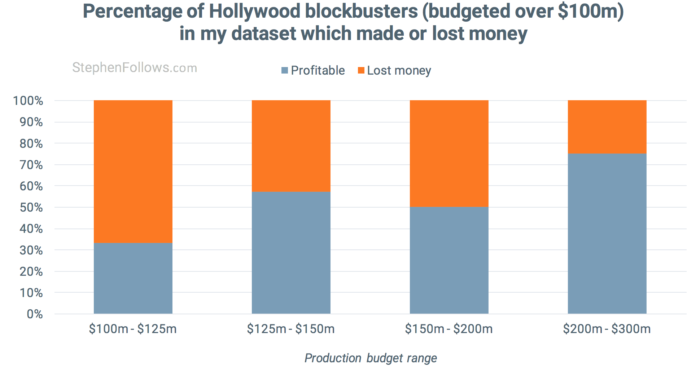
Then rather than looking at individual films, let's expect at the big pic. Imagine you are an investor who put in 1% to all the films in my dataset in return for 1% of the profits. For ease, we'll presume that you lot're contributing towards all costs, you receive a share of all income and that the studios take taken pity on you lot and (for some unknown reason) decided to exist honest with you nigh the numbers. Would you lot accept made a smart investment?
 Here are the combined financial figures for all 29 Hollywood blockbusters (approaching over $100m)…
Here are the combined financial figures for all 29 Hollywood blockbusters (approaching over $100m)…
- Total combined budgets: $iv.37 billion
- Total combined costs (including budgets, marketing and all other costs): $eleven.52 billion
- Total combined income (from all revenue streams): $eleven.95 billion
- Turn a profit across all movies: $428.nine million
- An boilerplate profit of $fourteen.eight million per movie
That means for your one% investment you lot would accept spent $115.2 one thousand thousand, received $119.5 1000000 back and made a turn a profit of $iv.3 million (i.e. a turn a profit margin of just 3.7%). Because that in that location is a filibuster between when you put the money in and when all revenue has been recouped, I think it'south certainly possible to imagine that you would lose this 'profit' to inflation.
If instead of playing with Hollywood you lot invested that same money in a standard high street banking company paying iii% annually, over 10 years your $115 million would get $156 one thousand thousand (an increase of 35%). And I am sure this is a fairly low return for that kind of cash.
Maybe instead of taking 1% of all the movies combined, you could endeavor and spot the winners ahead of time. Let's have a look at how the profit splits between the individual films…
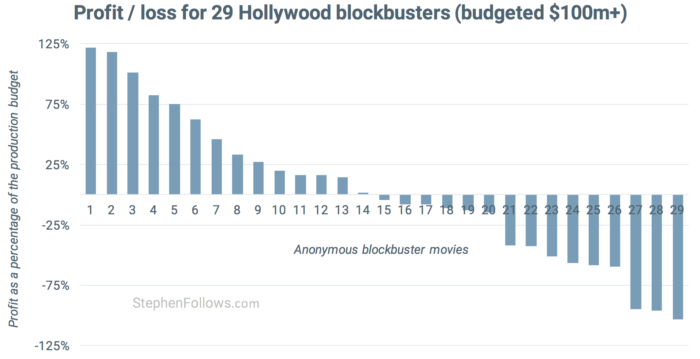
So if you managed to put all of your money into 'Picture show 1', so y'all would take a return of 122% (i.e. a $265.3 million render on an $119.5 one thousand thousand investment). The only problem is – how exercise yous spot the hits? Hollywood currently employs the smartest, best informed and nigh profit-focused people in an effort to exclusively make assisting movies and yet half of their movies lose coin. In fact, their combined best efforts only produce a iii.seven% profit margin.
Correlations and curiosities
Before we get out the mad, mad economics of Hollywood blockbusters, let's have a look at some interesting questions. (If y'all have a question not listed below, leave it in the comments at the bottom of the page and I'll practice my best to respond it from the data).
Q1: Are the films that make money better than those that lose money?
Yes, but only by a very modest margin. The boilerplate Metacritic score (i.e. average of picture critics out of 100) for assisting films was 55 and for unprofitable movies it was 49. Similarly, IMDb audiences rated the profitable films an average of 6.five out of 10 and the loss-making films an average of six.1.
So information technology doesn't seem as though the Hollywood studios have whatever financial incentive to make their films better. Shame.
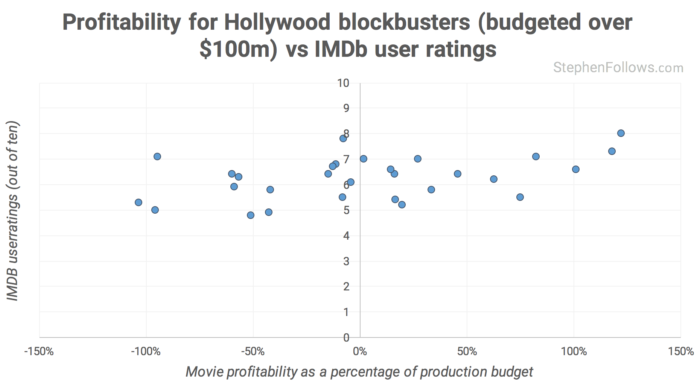
Q2: Does the amount they spend on marketing correlate with fiscal success?
In answering this question we have to be careful not to fall foul of the Statisticians' Mantra that 'Correlation is not causation'. Studios don't accept to lock in their marketing commitments until they get shut to the moving picture's release date and then it could be that they choose to double down on the marketing when they know they have a film which is likely to perform well. Likewise, if they think they have a real turkey on their easily they could dial back the marketing spend and so as non to throw good money after bad. From this data, we tin't tell why the correlation exists.
All the same, nosotros tin say that, yes, movies with the biggest marketing budgets do seem to gross the highest amounts at the box office.
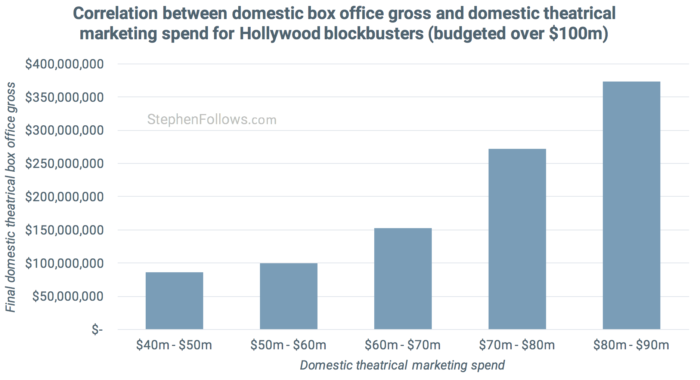
Q3: How important is the international market, compared to North America?
Hollywood makes blockbusters for global consumption and in contempo decades the share of the money the studios have received from countries outside the U.s. and Canada has grown considerably. In theory, increased international business comes with increased charges as much of the international moving-picture show business organisation is conducted through 3rd parties, which adds cost and complexity. Added to this, studios are less likely to brand missteps on their dwelling house turf every bit they can be on-hand to scrutinise everything to a greater extent. So, does this 'home advantage' make the domestic market more lucrative?
Well, it depends on which role of the process you lot wait at. Below you tin can see the origin of revenue and costs for the blockbusters in my dataset.
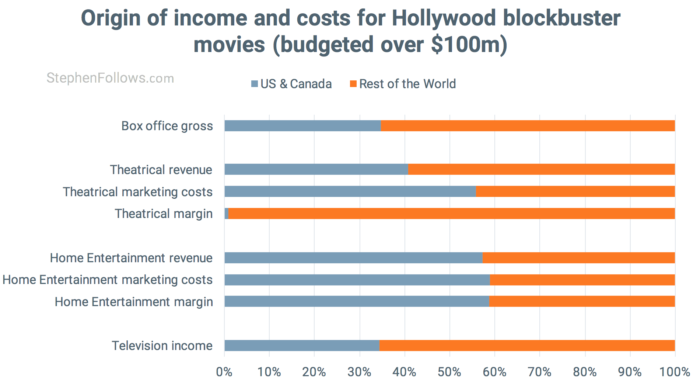
As you tin meet, the majority of the coin collected at the box function does indeed come up from countries outside of the US and Canada. Even so, studios spend a higher proportion of their marketing money in North America. This could be for a number of reasons including the higher price of advertisement in America, the temptation to spend more than in the country which studio execs actually live in and because the US is oftentimes the starting time place a movie is released and the media enjoy reporting on huge opening weekends (and decrying massive flops).
What's fascinating is that once you deduct the release and marketing costs (known every bit the "Prints and Advertising" or "P&A") virtually all (i.e. 99.ane%) of the theatrical margin left over comes from exterior Due north America. This is the event of high stock-still costs involved in releasing and marketing a flick in North America, the newspaper thin margins in the business organization (equally we saw higher up, it's under 4% across all these movies) and the more reliable nature of international returns. Together, they mean that only 12 of my 29 movies made coin at the domestic box function, whereas 20 made money at the international box office. Alongside this, the losses at the domestic theatrical marketplace were much worse than internationally. The poorest performing pic at the domestic theatrical marketplace lost $49.3 one thousand thousand whereas the poorest performing film at the international theatrical market just lost $14.8 million.
 Then Hollywood looks to the international market with glee because…
Then Hollywood looks to the international market with glee because…
- It'southward cheaper to market movies internationally, with the average moving-picture show in my dataset costing $55 one thousand thousand to market in the US and Canada and $44 million for every other country the motion-picture show was released in combined. For a sense of scale, IMDb lists release dates for Avatar in 69 countries, and I suspect the existent number is slightly higher.
- The margin is more reliable and less prone to huge theatrical losses. As nosotros saw higher up, the run a risk associated with releasing a big flick in North America is far greater than that associated with its international release.
- It has the most potential for growth in the near time to come as the North American marketplace is saturated with cinemas and movies. For instance, between 2009 and 2013, cinema admissions in Prc rose by 239%, whereas in the Usa over the same menses they shrunk by 5%. Yous tin can read more about the enormous growth in the movie business concern in China here stephenfollows.com/film-business-in-china
Q4: Is there a rule of thumb for guessing which Hollywood blockbusters are in profit?
 In the UK, the BFI developed a rule of thumb which stated that a movie was reasonably likely to be 'profitable' if it generated twice its upkeep at the global box function. They reached this conclusion by studying the full financial records of the movies they were involved with and also checking their hypothesis with independent professional flick financiers. But their dataset would have included few (if whatever) films budgeted over $100 million, and so information technology's interesting to encounter if it besides applies to my dataset of Hollywood blockbusters.
In the UK, the BFI developed a rule of thumb which stated that a movie was reasonably likely to be 'profitable' if it generated twice its upkeep at the global box function. They reached this conclusion by studying the full financial records of the movies they were involved with and also checking their hypothesis with independent professional flick financiers. But their dataset would have included few (if whatever) films budgeted over $100 million, and so information technology's interesting to encounter if it besides applies to my dataset of Hollywood blockbusters.
And so the question is… If we simply had two pieces of information – the global box part gross (equally reported on Box Office Mojo) and the product upkeep (every bit reported on Wikipedia) – how accurately could we judge how many $100m+ movies fabricated money?
Well, yous'd be right 83% of the fourth dimension. Using this dominion, I was able to correctly identify all of the profit-making films and correctly place ten equally loss-making, however, this system incorrectly marked five loss-making movies as beingness profitable. (I also tested the theory against the truthful upkeep figures due to the fact that Wikipedia budgets are mostly inflated, every bit previously discussed, but this only improved accuracy to 86%). In short, the rule works in effectually four out of five cases. Not as reliable as i might take liked (and way below the accurateness the BFI found when the rule is practical to smaller films) simply certainly interesting.
And then far, I've been using a dataset of 29 movies in my investigations. Just what happens if we apply this BFI rule to all $100m+ Hollywood blockbusters? I used simply the published upkeep and box office gross to await at the 263 $100m+ movies released between 2000 and 2015.
This rule suggests that 70% of Hollywood blockbusters budgeted over $100m and released betwixt 2000-15 were profitable. Since 2004, the percent of movies in profit has been slowly increasing, from 46% in 2004 to 76% of those released in 2015. Most interestingly, it doesn't seem that the huge number of releases in 2011 hurt profitability.
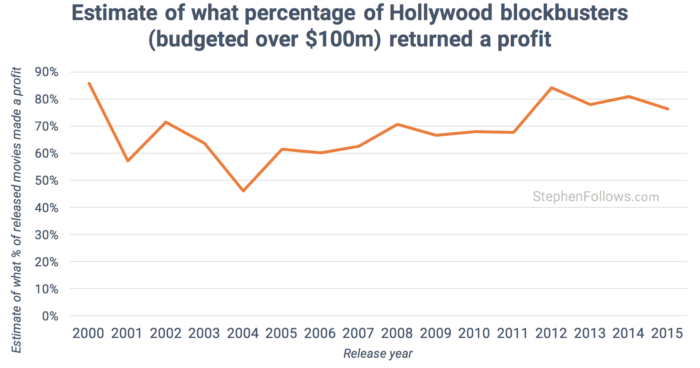
Epilogue
 So in that location yous have it – a rather long (sorry!) wait at how movies make money and why when a $100 meg movie makes $100 million in cinemas it's not automatically in turn a profit. I hope this has helped shed light on how Hollywood works and why the media'south traditional view of picture profitability is frustratingly wrong.
So in that location yous have it – a rather long (sorry!) wait at how movies make money and why when a $100 meg movie makes $100 million in cinemas it's not automatically in turn a profit. I hope this has helped shed light on how Hollywood works and why the media'south traditional view of picture profitability is frustratingly wrong.
The biggest question some readers may have at this phase is – how did he get this data? Almost of the raw data for today'south research is already publicly bachelor via releases and leaks from major Hollywood studios, it's just that I have spent the time to piece it together. I was also helped by a few well-placed friends in the manufacture who were able to make full in the blanks and ostend the veracity of some of the data points. I also used information from IMDb, Box Office Mojo, The Numbers, Metacritic and Wikipedia.
I am completely confident that the information in this commodity is a true representation of how these Hollywood blockbusters make money. The reason I am being a flake cagey nigh exactly where the information is from is partly to protect sources/ friends but too to avert inviting lawsuits. The purpose of this site is educational and my sole intention is to assist explain how our industry works. In the by, I have been contacted by lawyers for diverse companies, trying to prevent the sharing of fundamental data points relating to their business. So far, I have managed to avoid lawsuits and also to avoid having to take any manufactures down, but if I were to offer the full figures as a download (or details of how to exercise the same piecing together I take) and so I suspect I would go the wrong kind of attention.
So, if you want to know whatsoever more nearly these movies, please add your question in the comments below. I'll do my all-time to answer them all, including going back to the dataset if needed.
Next week I will look at movies costing under $100 million.
Source: https://stephenfollows.com/how-movies-make-money-hollywood-blockbusters/
Posted by: shafferwhow1970.blogspot.com

0 Response to "How Much Money Does The Average Movie Gross In Sales"
Post a Comment